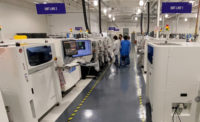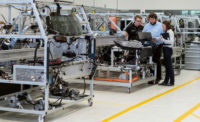The electric vehicle revolution is creating business opportunities for large and small manufacturers nationwide.
One such manufacturer is Pollington Machine Tool. Headquartered in Marion, MI, Pollington is a contract manufacturer with fabrication, metalworking and final assembly capabilities. Family-owned and operated since 1966, the company serves customers in the aerospace, defense and automotive industries.
Among the company’s newest customers is an OEM that makes electric vehicles. The OEM asked Pollington to produce the side rails for its EVs. Vital to an EV’s structural integrity, side rails are chassis assemblies that help contain the vehicle’s batteries, motors, electronic components, suspensions, wheels, and base structures. These assemblies are quite complex, consisting of 30 parts that range from long, machined extrusions to small clips and crush tubes.
To begin manufacturing the side rails, Pollington first had to meet safe launch qualifications. Most often used in the automotive industry, safe launch is a set of manufacturing practices that ensure the successful launch of a product while maintaining quality requirements.
To meet safe launch for the side rails, Pollington had to manufacture 4,000 assemblies with zero defects—2,000 for the left side and 2,000 for the right. Essentially, the company had to prove that it had a consistent, repeatable production process. This proved to be a challenge, even after three months of trying.
“We’d complete hundreds of assemblies only for one to be missing a clip,” says Pollington manufacturing engineer Chris Stewart. “That reset the counter to zero, and we’d start over to assemble 2,000 units.”
Despite having a well-documented process, improvements were needed to expedite the completion of safe launch as production volumes ramped up.
Paper instructions in physical binders proved insufficient for assemblers to learn and maintain consistency when building these complex components. To complicate matters, skilled labor is difficult to find in Marion, a tiny town with a population of approximately 900 people.
Pollington also needed to improve and increase the speed of traceability in the event of a quality issue. Traceability ensures that every step is meticulously recorded—from the torque applied to each fastener to the measurements taken of each part. All the data must be tied to a specific date and tool. This provides a detailed account of the assembly and validates critical parameters. A lack of traceability poses a significant challenge in ensuring that each facet of the production cycle adheres to the company’s standards and protocols.
“As a Tier 1 in automotive, you must have tight traceability. If there’s a quality concern, you need to be able to react very quickly to identify and isolate those parts. The OEMs need answers in minutes to keep their production lines running,” explains engineering manager Brian Priddle.
“With the old way of doing everything on paper, it was kind of hard to find the information you needed if there were questions,” adds Stewart.
Searches could take hours.
MES Software Solves the Problem
To modernize its assembly processes, Pollington implemented digital work instructions from Pico MES. The software enables images with annotations and video explanations, along with Spanish work instructions to guide operators through each step of the side rail assembly. Before advancing to the next operation, the software verifies that all steps have been correctly followed.
“It is easy to follow along with the instructions. You could build the assembly without any prior training,” says Stewart.
Implementing the software was relatively quick. “We spent about a week developing our system,” says Stewart. “Then, we spent two to three days making sure everything was in place, including training. In less than two weeks, we were analyzing the manufacturing data.”
In just 12 months, Pollington had digitized its assembly operations: 18 workstations were connected to the software; 100 processes were migrated from paper to digital; and 56 tools integrated with the software for error-proofing.
The digital work instructions helped immensely with on-the-fly training. More importantly, “the digital work instructions helped us pass the safe launch within two weeks,” adds Priddle. “That was a big deal.”
Traceability Unlocks a New Experience
The software has also improved traceability.
“Now, I can just go into Pico MES and plug in a serial number or a lot number, and the data is all there,” says Stewart. “That has saved so much time, and it’s such a streamlined, easy process. We get a lot of value from using Pico. It’s really helped make us more efficient.”
Pollington plans to integrate more off-the-shelf tools into its digital workflow.
“We’re going to start collecting every piece of data we can with Pico MES,” Priddle says. “This high level of traceability with digital data records is opening up many possibilities for continuous improvement.”
Pollington also plans to leverage Pico to improve the customer experience. When Pollington has a robust traceability data set, it plans to allow customers to access some information directly to get answers immediately. “They wouldn’t even have to call us at that point,” says Priddle.
For more information, visit www.picomes.com.
ASSEMBLY ONLINE
For more information on MES software, visit www.assemblymag.com to read these articles:
New Software Promises to Increase Quality, Flexibility and Resilience
Process Improvement in Product Assembly
Software Improves Assembly of Wheelchairs





